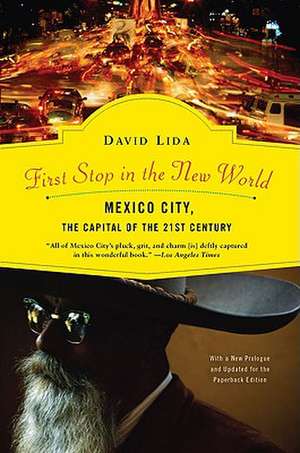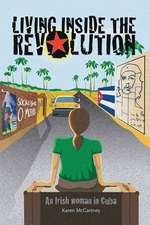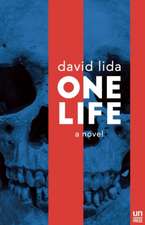First Stop in the New World: Mexico City, the Capital of the 21st Century
Autor David Lidaen Limba Engleză Paperback – 31 mai 2009 – vârsta de la 18 ani
The definitive book on Mexico City: a vibrant, seductive, and paradoxical metropolis-the second-biggest city in the world, and a vision of our urban future.
First Stop in the New World is a street-level panorama of Mexico City, the largest metropolis in the western hemisphere and the cultural capital of the Spanish- speaking world. Journalist David Lida expertly captures the kaleidoscopic nature of life in a city defined by pleasure and danger, ecstatic joy and appalling tragedy-hanging in limbo between the developed and underdeveloped worlds. With this literary-journalist account, he establishes himself as the ultimate chronicler of this bustling megalopolis at a key moment in its-and our-history.
First Stop in the New World is a street-level panorama of Mexico City, the largest metropolis in the western hemisphere and the cultural capital of the Spanish- speaking world. Journalist David Lida expertly captures the kaleidoscopic nature of life in a city defined by pleasure and danger, ecstatic joy and appalling tragedy-hanging in limbo between the developed and underdeveloped worlds. With this literary-journalist account, he establishes himself as the ultimate chronicler of this bustling megalopolis at a key moment in its-and our-history.
Preț: 136.71 lei
Nou
Puncte Express: 205
Preț estimativ în valută:
26.16€ • 27.15$ • 21.87£
26.16€ • 27.15$ • 21.87£
Carte disponibilă
Livrare economică 24 februarie-10 martie
Preluare comenzi: 021 569.72.76
Specificații
ISBN-13: 9781594483783
ISBN-10: 1594483787
Pagini: 358
Dimensiuni: 139 x 210 x 20 mm
Greutate: 0.34 kg
Editura: Riverhead Books
ISBN-10: 1594483787
Pagini: 358
Dimensiuni: 139 x 210 x 20 mm
Greutate: 0.34 kg
Editura: Riverhead Books
Extras
Introduction: The Hypermetropolis
From my first visit as a tourist, Mexico enchanted me. I kept returning, but for four years didn't dare set foot in Mexico City. I was afraid of the capital, influenced by the propaganda dismissing it as a teeming, overpopulated, polluted bedlam, full of horrific testimonies of insuperable poverty. I imagined the armless beggars of Calcutta brandishing their stumps in tourists' faces, hoping the display would result in a handout.
Then, during one holiday in 1987, I had a layover in Mexico City. In the hour-long taxi ride from the airport to the hotel, I fell in love. I was astonished by the streets of the centro histórico, lined with massive stone buildings constructed by the Spanish conquerors in the sixteenth and seventeenth centuries. I was captivated by the contrast between the grandiosity of those structures and the humility of the office workers wending their way through the sidewalks— the smiling shoeshine man at his electric-orange post, the doughy matron in the blue skirt and white apron beseeching me to buy tacos sudados—"sweaty tacos," so called because they are steamed in a basket.
That afternoon I sipped coffee on a hotel balcony overlooking the zócalo, the city's enormous central square. A crowd began to gather in support of a teachers' strike. By twilight they would be one hundred thousand strong, yet an hour later everyone was gone, the plaza empty, as if it had been a hallucination.
At night I wandered along those streets dense with history, lit so dimly they appeared to be in black-and-white. In a crowded cafeteria, I ate tamales wrapped in banana leaves and stuffed with spicy pork. I drank tequila in a dark bar, where a round man with slick hair and a pencil mustache sang romantic songs, backed by three guitar players dexterously crowding notes into each phrase.
I stumbled upon Plaza Garibaldi, the rowdy nocturnal soul of the city. Squadrons of musicians, mostly mariachis in skintight, tin- studded black suits, trawled for customers willing to pay a few pesos for a melody. When they found temporary patrons, throngs gathered, and the most boisterous revelers sang along. It was a crowded Friday night, and the result was the most singular cacophony I'd ever heard.
In Garibaldi's most humble cantina, La Hermosa Hortensia— which dispenses pulque, a fermented cactus beverage created by the Aztecs—a staggeringly drunken man offered me his wife. She demonstrated her eagerness to consummate the proposition with a squeeze of my thigh and a smile, the seductiveness of which was undercut by the absence of several crucial teeth. I refused with as much courtesy as possible, after which the man removed from his neck, and gave me, a string that held an emblem of Mexico's patron saint, the Virgin of Guadalupe.
Before I went to bed, half-drunk in the wee hours, I watched a lonely group of soldiers in ill-fitting uniforms on drill in the otherwise empty zócalo. Unfortunately, I had to leave the next day. I had been utterly seduced by the constant sensations of contrast, surprise, even tumult. Within three years I would be living there.
That Mexico City was such a beguiling place came as a complete surprise. The 1980s were surely the worst moment in its history. Three million autos, the thin air of its 7,300-foot altitude, and the thirteen thousand factories that ringed the valley in which it is situated created an ecological nightmare with toxic levels of pollution.
The pumping of a billion gallons of water per day from as far away as fifty miles caused the city to sink 3.5 inches a year, and the lack of adequate plumbing and drainage made it a nightmare for many of its residents.
Said to be the biggest city in the world, by the early 1980s Mexico City had a population of seventeen million, and the government predicted that there would be thirty-six million by the year 2000. Most of the new inhabitants were squatters, streaming in from the impoverished countryside at a rate of a couple of thousand per day, creating slapdash shantytowns on the ever-expanding outskirts.
In the immediate aftermath of a devastating earthquake in 1985 the government seemed to disappear into thin air, and it was up to the citizens to rescue one another from under the rubble. Not only was there a lack of viable leadership, but politicians and police chiefs were noted more for how much they stole from the public trough than for any constructive projects they carried out.
If Mexico City today is still a challenging and sometimes exhausting place to live, with permanent service problems (principally in drainage, water pumping, and distribution) and a continued resistance to urban planning, it is worth pointing out that the worst predictions from the 1980s did not come to pass.
While pollution levels may still be unacceptably high, the situation is no longer a noxious horror. Since 1991, all new cars here have come with catalytic converters, and although four million or so make traffic a nightmare, they are not causing as much lethal damage as they did twenty years ago. Most of the factories in the valley have closed down, making way for a greater service economy and cleaner air. Plumbing has reached virtually 100 percent of the city, even in the most impoverished outskirts.
Mexico's is the second most dynamic economy in Latin America, after Brazil's, but its wealth is scandalously distributed. While Mexico City's gross domestic product is over seventeen thousand dollars U.S. per capita, half of the capital's residents live at or near the poverty level, and about 15 percent beneath it. At the same time, virtually everyone has a roof over his or her head, electricity, running water, and a TV set. More than half have cell phones. If someone starves to death in the capital, it is an anomaly. (This is in contrast to other parts of Mexico, mainly rural, that the United Nations has compared to Africa for their destitution.)
That effectively everyone in Mexico City eats goes a long way in explaining why the population has held fairly steady since the early 1990s, increasing by only a few million souls. Word finally reached those rural Mexicans who flooded the city for decades that the capital was no longer providing survival or sustenance as it had before. Those same Mexicans began to stream across the border into the United States, and continue to do so, despite mounting political pressure from the U.S. government to stop their flow. It is no longer "the biggest city on earth," if it ever could have been accurately counted as such. Others such as Los Angeles have a far greater land mass, and several years ago the Tokyo-Yokahama corridor replaced Mexico City as the world's most populous metropolis. Numerous other cities, although with fewer residents, have far greater population density. Mexico City has eighty-four hundred people per square kilometer, while Mumbai, Lagos, Karachi, and Seoul have more than double that figure. Bogotá, Shanghai, Lima, and Taipei also are significantly more jam-packed.
If Mexico City is a demanding place to live, it is also an extremely rewarding one. The hypercity, the ur-urb of the American continent, it is improving all the time as a cultural capital, with offerings more along the lines of First World cities than any other in Latin America. Its scores of museums and galleries have produced artists who exhibit around the world. On any given night there is an extensive selection of theater (classical, contemporary, experimental), film (mostly from Hollywood, but also from France, Japan, Romania, or Argentina), music (from the local symphony orchestra, to an avant-garde jazz combo from New York, to touring rappers from Beirut), and public presentations of just-published books.
There are limitless choices of food and drink. Mexican cuisine is unique; its play of colors, textures, temperatures, and flavors makes it the culinary jewel of the continent. One can sit in the cocoon of an elegant restaurant (choices include not only Mexican food, but the cookery of Poland, Lebanon, Japan, France, or Catalonia) or else be tempted by the open air; in Mexico City there is a complex street theater to the food stalls, enticing passersby with assorted aromas and hues.
Paradoxically, given its population of twenty million, there are many tree-lined neighborhoods with the quiet sociability of small towns, while others have the generic international-hip vibe one finds around the Bastille in Paris, Williamsburg in New York, or Soho in Hong Kong. Its citizens may be savages when behind the wheels of their cars, but on the street there is a level of courtesy today found in few cities in prosperous countries. In the capital, waiters in cantinas shake hands with their familiar customers, and after your food has been served at a restaurant, people at the next table are likely to say buen provecho (the local equivalent to bon appétit). People hold doors open for each other, say good morning when they walk into an elevator, kiss each other's cheeks when they are introduced. If you sneeze in public, a chorus of voices says salud. It sometimes takes five minutes to get out of a taxi until all of the ritual phrases of "At your service" and "Have a good day" and "Take care of yourself" have been exchanged.
Mexico City was founded by the Aztecs in 1325 as Tenochtitlán. Built on an island in Lake Texcoco, within the next two centuries, through an inspired system of man-made islands, canals, and causeways, it grew into the seat of the Aztec empire. By the time the Spaniards arrived in 1519, Tenochtitlán was one of the world's largest cities, with a population of about two hundred thousand. It was a city of pyramids and palaces, the majesty of which stunned the conquerors. Nonetheless, the Spanish promptly destroyed that city and built their own stone citadels atop the ruins. Mexico City became New Spain's headquarters. Much of the colony's Central American and Caribbean assets were administered from the capital. The colony lasted nearly three hundred years.
The capital's history in the nineteenth century was marked by violence. After the War of Independence liberated the country from Spain in 1810, the battles were internal, but in 1847 the United States invaded Mexico City, and the upshot of the resultant occupation was the sale of half of its territory at bargain-basement prices to its northern neighbor. From 1864 to 1867, Mexico was occupied by Maximilian of Hapsburg, who built the splendid Chapultepec Castle in the heart of the capital. The last decades of the century were marked by the dictatorship of Porfirio Díaz, whose governing style was known as pan o palo (bread or the stick) : those who marched in line for him received sustenance, while those who disobeyed were met with brutality. Mexico's entrance into the modern era was also turbulent, with carnage rocking the capital not only during the Revolution of 1910, but continuing well into the subsequent decade.
After peace was restored, by the middle of the twentieth century Mexico City was known for its fresh air, clear skies, and for being Latin America's most cosmopolitan capital. At this point, while the city's growth was under control, each new neighborhood basically imitated the historic center of the city, usually spreading outward from a tree-lined square with the area's most important church and local government buildings. Yet in the second half of the twentieth century, Mexico City became the poster child of contemporary urban chaos and overdevelopment. Between 1950 and 2000, its population grew from roughly three million to about twenty million.
The city expanded horizontally in all four directions, swallowing and engulfing other towns, villages, and municipalities in a willy-nilly, ad hoc manner. During those fifty years, what passed for urban planning allowed for no more than catch-up, reactive measures. For example, the inner-city throughways, such as the Viaducto and the Periférico, became obsolete almost as soon as they were completed, given how quickly the population and its fleet of cars grew during the years they were built.
Apart from the obvious problems of traffic and transportation, the growth created other confusing complications. Today, out of the city's eighty-five thousand streets, there are about eight hundred fifty called Juárez, seven hundred fifty named Hidalgo, and seven hundred known as Morelos. Two hundred are called 16 de Septiem bre, while a hundred more are called 16 de Septiembre Avenue, Alley, Mews, or Extension. Nine separate neighborhoods are called La Palma, four are called Las Palmas, and there are numerous mutations: La Palmita, Las Palmitas, Palmas Inn, La Palma Condominio, Palmas Axotitla, La Palma I y Palma I-II Unidad Habitacional.
Today, greater Mexico City is composed of the Federal District, home to approximately eight million residents. The other twelve million live in nearly sixty municipalities in Mexico State, which make up the rest of the urban sprawl to the east, west, and north. The Federal District is divided into sixteen delegations (the equivalent of boroughs in New York, subregions in London, or arrondissements in Paris), each with its own somewhat autonomous government. Only four of the delegations are considered the center of the city. Like most big metropoli, Mexico City is divided into smaller, sharply contrasting, and mostly self-contained neighborhoods that are called colonias. There are about five thousand in greater Mexico City.
Compounding the city's complications is the fact that the Federal District exists in a political and judicial limbo. It is neither a state nor a territory that belongs to another state. It is not sovereign. For most of its budget, it is dependent on the largesse of the federal government, to which it has had an increasingly antagonistic relationship in the last decade or so. Although it generates about half of the country's federal taxes and close to 25 percent of Mexico's gross domestic product, the Federal District receives only about seven centavos for every peso it delivers to the national treasury, as opposed to the states, which receive about double that amount.
It is an architectural eyesore. In any given neighborhood, sometimes within a block or two, there can be an elegant nineteenth-century mansion next to a squat and brightly painted Art Deco apartment house. Close by will be a pink Swiss chalet adjacent to a modernist nightmare that rises from the ground in the form of a tube. Around the corner is a gray concrete bunker opposite the husk of a construction that crumbled in the 1985 earthquake.
Although it has a few distinctive monuments, such as the statues of the Angel of Independence and Diana the Huntress on the broad avenue Paseo de la Reforma (the city's answer to the Champs Élysées), Mexico City defies physical description and lacks notable iconography. A few neighborhoods, such as the centro, San Ángel, and Coyoacán, have lovely colonial architecture, while quite a few more (Condesa, Juárez, Narvarte, Santa María la Ribera) have Art Deco or neo colonial buildings. But the pretty areas are exceptions. Architects describe Mexico City as "short and fat," given the number of one-, two-, and three-story buildings in its seemingly infinite land mass. Many of those buildings are unfinished, with rebar sprouting from the top in anticipation of the day its residents can afford to build another story.
Much of public space has been raped. Enormous billboards are not only in your face on the inner-city highways, but also hover over the main boulevards, and even in residential neighborhoods are painted on the sides of buildings or hang like banners over bal- conies and terraces. Others are pasted on walls hastily constructed beside empty lots. In the subway tunnels between certain stations, hologram ads for cars are projected out the windows, as if mocking the very people who can't afford to buy one.
From time to time the city government makes a big noise about how it will soon be clamping down on this mostly illegal signage. Rarely does anything happen beyond pasting large signs over the offending ads that make clear in bold type that they are there unlawfully. So we are left with blemishes on the cityscape partially obstructing other blemishes.
Walter Benjamin called Paris the capital of the nineteenth century, and in Delirious New York Rem Koolhaas posited Manhattan as the urban Rosetta stone of the twentieth. Mexico City will play a similar role in the twenty-first. The orderly European model for cities, and even the bustling but carefully planned United States archetypes that followed it, have already given way to another version. Today, more than half of the people in the world live in cities. Most of us do not live in neat, orderly ones, like London and Toronto, Paris and New York. We live in enormous, improvised hypermetropoli, cities that in the past few decades, with little or nothing resembling urban planning, have expanded to accommodate monstrously multiplying populations. Mumbai, Shangai, Istanbul, São Paulo, Lagos, Cairo, and Karachi, to give a few examples, each have more than ten million inhabitants, often struggling over inches of space.
Only a three-hour plane ride from L.A. and four and a half from New York City, of all these cities, Mexico City is the closest geographically to the U.S. and Canada (and, except for Istanbul, to Europe). Catholic and Spanish-speaking, it is also the closest to the U.S., Canada, and Europe in sociocultural terms. Like those other cities mentioned, it has absorbed and swallowed all the centuries of its history, yet most of them are still in evidence in some regurgitated form on the street.
Not all of those cities are alike, and each deserves its own book. But if you get a glimpse of how Mexico City works—economically, socially, culturally, politically, and sexually—and begin to understand how its residents live, you will at least have a clue as to how many of the people in the world survive.
Moreover, Mexico City makes the great capitals of the last century seem somewhat less relevant and certainly less spontaneous. Perhaps because of the stratospheric prices of real estate, it is increasingly harder to be surprised by anything in New York, Paris, or London, yet Mexico City is constantly improvising a new invention of itself. Further, as the divide between the rich and the poor becomes ever more abysmal, those First World cities are slowly becoming more like Mexico City, with their schisms between haves (natives and others from prosperous backgrounds) and have-nots (usually down-on-their-luck immigrants and their children).
Globalization is making prosperous cities more alike and less idiosyncratic. New York is the most emblematic example. Today in Manhattan there is a bank branch and a Duane Reade drugstore on nearly every block. Yet most of the distinctive places that defined New York as little as twenty years ago have disappeared—from the secondhand bookstores that lined Fourth Avenue to the dozen art cinemas that existed in various neighborhoods, to music venues like CBGB (where the punk movement exploded in the United States) and Folk City (where Bob Dylan and Simon &Garfunkel had their first New York gigs) and any number of jazz clubs (Bradley's, The Cookery, Gregory's). Most of the department stores—Gimbel's, Orbach's, Klein's, B. Altman, Bonwit Teller—have disappeared, because so many buy their clothes at the Gap, Banana Republic, and the same stores whose outlets exist in the rest of the country. Famously, the sleazy movie theaters, grind-house porno emporiums, and neon video game parlors of Times Square were turned into a Disneyland fit for family consumption, with flagship stores of Nike, Swatch, Toys "R" Us, Hello Kitty, and Disney itself.
Meanwhile, at least in the short term, globalization makes Mexico City a more appealing place to live. Given its enormity, it was quite homogeneous until the early 1990s, ripe for some international infusion. An increasing population from the United States, Europe, South America, Asia, and the Caribbean has added to the city's integral excitement, enhancing the city with added elements of their own cultures. On any given evening you can have dinner in Koreatown on the fringes of the Zona Rosa, then go on to see a film from Thailand or dance in a nightclub to a Cuban band.
For most of the foreigners who arrive, it's a pretty good place to live, undoubtedly better than for the majority of the Mexicans. Most Argentines, Colombians, and Cubans find better opportunities for employment than their crumbling economies can offer, and a few have come to escape political persecution. Some Europeans and Americans are wowed by the chance to live a lusher lifestyle than at home, complete with enormous apartments equipped with maids they can bully. To others of a more Bohemian bent, it's the best thing since Paris of the 1920s, complete with cantinas, dance halls, and unbearable poètes maudits.
While foreigners here, principally Europeans, complain about the proliferation of Starbucks and Wal-Marts, middle-class Mexicans revel in the First World status bestowed by these establishments. What's more, despite globalization, the city, so far, has largely maintained its idiosyncratic identity. Mexico City still remains an emphatically Mexican city, with sprawling open-air markets in many ways like those that astonished the Spaniards in the sixteenth century; salesmen who bicycle their way through residential neighborhoods each evening, peddling Oaxacan tamales; and literally millions who improvise their livings on one sidewalk or another.
Economically, Mexico City exists in a sort of limbo between the developed and underdeveloped worlds. Far from impoverished, according to a 2005 Price Waterhouse Coopers survey, it had the eighth largest GDP of any city in the world. However, the wealth is scandalously distributed. Perhaps 15 percent of its population has at least a considerable amount of discretionary income, and the top tier of that stratum is staggeringly wealthy. Yet not only does roughly half the population live at the poverty level, close to fifty percent makes its living from the underground economy, counting on no protection or benefits from any institution.
While it can be instructive to compare Mexico City to New York, Paris, or London, the way that it grew in the second half of the twentieth century is emblematic of how big cities have enlarged in most countries in the same period. The way it is dealing with its problems, however haphazardly, might be instructive for other cities as they try to solve theirs.
Despite its improvements, Mexico City has still maintained a largely lurid reputation. Much of that status is the result of a series of events that set Mexico on its ear in 1994. Near the northern border, Luis Donaldo Colosio, a presidential candidate, was assassinated in front of the crowd while at a campaign stop, and at the southern pole of the country there was a guerrilla uprising among peasants in Chiapas. An economic crash devalued the peso by half.
The clearest manifestation of the center not holding in Mexico City was a crime wave, during which the capital became notorious for street holdups, express kidnappings in taxicabs, and cops who used their uniforms to shake down the citizenry. Although statistical and anecdotal evidence suggest that the city is safer than it was a decade ago, it hasn't yet been able to live down that reputation. While there is no denying that on a daily basis in Mexico City there are too many robberies and traffic accidents (and sometimes kidnappings or grisly murders), in fact most of its population gets through its days and nights without either committing or being victims of crimes, and without being any more exploited than the residents of cities with similar economies. Given how much that could go wrong here, I am constantly amazed at how well it functions, largely due to Mexicans' talent for improvisation and ingenuity.
I am not suggesting that Mexico City is no longer a complicated, challenging, and often difficult place to live. But part of what makes a city dynamic is the way that its citizens deal with its problems, and people here are nothing if not imaginative at problem solving. Indeed, the Mexicans and their ingenuity are very much a part of what gives Mexico City its dynamic energy.
At the time of this writing, for more than a decade the Mexican peso has held steady at an exchange rate of between ten and eleven to the dollar, with fluctuations as high as twelve and as low as nine. In the context of the past forty years, this represents unprecedented economic stability. Since the early 1970s, the peso tended to crash at a rate of once every six years, sometimes even more frequently, resulting in devaluations of 50 percent or more. Inflation rates throughout the 1980s tended to oscillate between 60 percent and 100 percent per year.
However, there is no guarantee of the Mexican economy's everlasting solidity. Nor does the peso represent most of the world's reference mark for foreign-exchange rates. For these reasons, when I mention how much something costs, I have chosen to note its price in dollars, except where otherwise indicated.
I have lived in Mexico City off and on (mostly on) since 1990, and have never felt so much at home anywhere else in the world. Primarily, I have made my living as a freelance journalist. My curiosity has been scrupulously promiscuous. To give an idea, I've written articles about a president and a Nobel Prize winner, a woman bullfighter and a deaf-mute transvestite, a dog trainer, a private detective, and a pornographic movie actor. I've interviewed a tailor who custom makes suits for politicians, a dollar-a-dance hostess, five men who imitate the pop star Juan Gabriel, and a man who draws caricatures with pancake batter as his medium and a griddle as his canvas.
In this book, with the help of all those people, Mexico City will be reflected from the street level. They will provide the details of the cityscape; I'll complement with the backdrop. Every writer is at least unconsciously trying to fashion a narrative with which he can live. While this book is about Mexico City, it is reflected through my idiosyncratic gaze and experience. If one fact stands out more than any other, it is that in the past eighteen years I have never been bored here. All those people have kept me alive and awake, have kept me in Mexico City, have helped me to make it my home. I hope the book reads as a love letter to them.
From my first visit as a tourist, Mexico enchanted me. I kept returning, but for four years didn't dare set foot in Mexico City. I was afraid of the capital, influenced by the propaganda dismissing it as a teeming, overpopulated, polluted bedlam, full of horrific testimonies of insuperable poverty. I imagined the armless beggars of Calcutta brandishing their stumps in tourists' faces, hoping the display would result in a handout.
Then, during one holiday in 1987, I had a layover in Mexico City. In the hour-long taxi ride from the airport to the hotel, I fell in love. I was astonished by the streets of the centro histórico, lined with massive stone buildings constructed by the Spanish conquerors in the sixteenth and seventeenth centuries. I was captivated by the contrast between the grandiosity of those structures and the humility of the office workers wending their way through the sidewalks— the smiling shoeshine man at his electric-orange post, the doughy matron in the blue skirt and white apron beseeching me to buy tacos sudados—"sweaty tacos," so called because they are steamed in a basket.
That afternoon I sipped coffee on a hotel balcony overlooking the zócalo, the city's enormous central square. A crowd began to gather in support of a teachers' strike. By twilight they would be one hundred thousand strong, yet an hour later everyone was gone, the plaza empty, as if it had been a hallucination.
At night I wandered along those streets dense with history, lit so dimly they appeared to be in black-and-white. In a crowded cafeteria, I ate tamales wrapped in banana leaves and stuffed with spicy pork. I drank tequila in a dark bar, where a round man with slick hair and a pencil mustache sang romantic songs, backed by three guitar players dexterously crowding notes into each phrase.
I stumbled upon Plaza Garibaldi, the rowdy nocturnal soul of the city. Squadrons of musicians, mostly mariachis in skintight, tin- studded black suits, trawled for customers willing to pay a few pesos for a melody. When they found temporary patrons, throngs gathered, and the most boisterous revelers sang along. It was a crowded Friday night, and the result was the most singular cacophony I'd ever heard.
In Garibaldi's most humble cantina, La Hermosa Hortensia— which dispenses pulque, a fermented cactus beverage created by the Aztecs—a staggeringly drunken man offered me his wife. She demonstrated her eagerness to consummate the proposition with a squeeze of my thigh and a smile, the seductiveness of which was undercut by the absence of several crucial teeth. I refused with as much courtesy as possible, after which the man removed from his neck, and gave me, a string that held an emblem of Mexico's patron saint, the Virgin of Guadalupe.
Before I went to bed, half-drunk in the wee hours, I watched a lonely group of soldiers in ill-fitting uniforms on drill in the otherwise empty zócalo. Unfortunately, I had to leave the next day. I had been utterly seduced by the constant sensations of contrast, surprise, even tumult. Within three years I would be living there.
That Mexico City was such a beguiling place came as a complete surprise. The 1980s were surely the worst moment in its history. Three million autos, the thin air of its 7,300-foot altitude, and the thirteen thousand factories that ringed the valley in which it is situated created an ecological nightmare with toxic levels of pollution.
The pumping of a billion gallons of water per day from as far away as fifty miles caused the city to sink 3.5 inches a year, and the lack of adequate plumbing and drainage made it a nightmare for many of its residents.
Said to be the biggest city in the world, by the early 1980s Mexico City had a population of seventeen million, and the government predicted that there would be thirty-six million by the year 2000. Most of the new inhabitants were squatters, streaming in from the impoverished countryside at a rate of a couple of thousand per day, creating slapdash shantytowns on the ever-expanding outskirts.
In the immediate aftermath of a devastating earthquake in 1985 the government seemed to disappear into thin air, and it was up to the citizens to rescue one another from under the rubble. Not only was there a lack of viable leadership, but politicians and police chiefs were noted more for how much they stole from the public trough than for any constructive projects they carried out.
If Mexico City today is still a challenging and sometimes exhausting place to live, with permanent service problems (principally in drainage, water pumping, and distribution) and a continued resistance to urban planning, it is worth pointing out that the worst predictions from the 1980s did not come to pass.
While pollution levels may still be unacceptably high, the situation is no longer a noxious horror. Since 1991, all new cars here have come with catalytic converters, and although four million or so make traffic a nightmare, they are not causing as much lethal damage as they did twenty years ago. Most of the factories in the valley have closed down, making way for a greater service economy and cleaner air. Plumbing has reached virtually 100 percent of the city, even in the most impoverished outskirts.
Mexico's is the second most dynamic economy in Latin America, after Brazil's, but its wealth is scandalously distributed. While Mexico City's gross domestic product is over seventeen thousand dollars U.S. per capita, half of the capital's residents live at or near the poverty level, and about 15 percent beneath it. At the same time, virtually everyone has a roof over his or her head, electricity, running water, and a TV set. More than half have cell phones. If someone starves to death in the capital, it is an anomaly. (This is in contrast to other parts of Mexico, mainly rural, that the United Nations has compared to Africa for their destitution.)
That effectively everyone in Mexico City eats goes a long way in explaining why the population has held fairly steady since the early 1990s, increasing by only a few million souls. Word finally reached those rural Mexicans who flooded the city for decades that the capital was no longer providing survival or sustenance as it had before. Those same Mexicans began to stream across the border into the United States, and continue to do so, despite mounting political pressure from the U.S. government to stop their flow. It is no longer "the biggest city on earth," if it ever could have been accurately counted as such. Others such as Los Angeles have a far greater land mass, and several years ago the Tokyo-Yokahama corridor replaced Mexico City as the world's most populous metropolis. Numerous other cities, although with fewer residents, have far greater population density. Mexico City has eighty-four hundred people per square kilometer, while Mumbai, Lagos, Karachi, and Seoul have more than double that figure. Bogotá, Shanghai, Lima, and Taipei also are significantly more jam-packed.
If Mexico City is a demanding place to live, it is also an extremely rewarding one. The hypercity, the ur-urb of the American continent, it is improving all the time as a cultural capital, with offerings more along the lines of First World cities than any other in Latin America. Its scores of museums and galleries have produced artists who exhibit around the world. On any given night there is an extensive selection of theater (classical, contemporary, experimental), film (mostly from Hollywood, but also from France, Japan, Romania, or Argentina), music (from the local symphony orchestra, to an avant-garde jazz combo from New York, to touring rappers from Beirut), and public presentations of just-published books.
There are limitless choices of food and drink. Mexican cuisine is unique; its play of colors, textures, temperatures, and flavors makes it the culinary jewel of the continent. One can sit in the cocoon of an elegant restaurant (choices include not only Mexican food, but the cookery of Poland, Lebanon, Japan, France, or Catalonia) or else be tempted by the open air; in Mexico City there is a complex street theater to the food stalls, enticing passersby with assorted aromas and hues.
Paradoxically, given its population of twenty million, there are many tree-lined neighborhoods with the quiet sociability of small towns, while others have the generic international-hip vibe one finds around the Bastille in Paris, Williamsburg in New York, or Soho in Hong Kong. Its citizens may be savages when behind the wheels of their cars, but on the street there is a level of courtesy today found in few cities in prosperous countries. In the capital, waiters in cantinas shake hands with their familiar customers, and after your food has been served at a restaurant, people at the next table are likely to say buen provecho (the local equivalent to bon appétit). People hold doors open for each other, say good morning when they walk into an elevator, kiss each other's cheeks when they are introduced. If you sneeze in public, a chorus of voices says salud. It sometimes takes five minutes to get out of a taxi until all of the ritual phrases of "At your service" and "Have a good day" and "Take care of yourself" have been exchanged.
Mexico City was founded by the Aztecs in 1325 as Tenochtitlán. Built on an island in Lake Texcoco, within the next two centuries, through an inspired system of man-made islands, canals, and causeways, it grew into the seat of the Aztec empire. By the time the Spaniards arrived in 1519, Tenochtitlán was one of the world's largest cities, with a population of about two hundred thousand. It was a city of pyramids and palaces, the majesty of which stunned the conquerors. Nonetheless, the Spanish promptly destroyed that city and built their own stone citadels atop the ruins. Mexico City became New Spain's headquarters. Much of the colony's Central American and Caribbean assets were administered from the capital. The colony lasted nearly three hundred years.
The capital's history in the nineteenth century was marked by violence. After the War of Independence liberated the country from Spain in 1810, the battles were internal, but in 1847 the United States invaded Mexico City, and the upshot of the resultant occupation was the sale of half of its territory at bargain-basement prices to its northern neighbor. From 1864 to 1867, Mexico was occupied by Maximilian of Hapsburg, who built the splendid Chapultepec Castle in the heart of the capital. The last decades of the century were marked by the dictatorship of Porfirio Díaz, whose governing style was known as pan o palo (bread or the stick) : those who marched in line for him received sustenance, while those who disobeyed were met with brutality. Mexico's entrance into the modern era was also turbulent, with carnage rocking the capital not only during the Revolution of 1910, but continuing well into the subsequent decade.
After peace was restored, by the middle of the twentieth century Mexico City was known for its fresh air, clear skies, and for being Latin America's most cosmopolitan capital. At this point, while the city's growth was under control, each new neighborhood basically imitated the historic center of the city, usually spreading outward from a tree-lined square with the area's most important church and local government buildings. Yet in the second half of the twentieth century, Mexico City became the poster child of contemporary urban chaos and overdevelopment. Between 1950 and 2000, its population grew from roughly three million to about twenty million.
The city expanded horizontally in all four directions, swallowing and engulfing other towns, villages, and municipalities in a willy-nilly, ad hoc manner. During those fifty years, what passed for urban planning allowed for no more than catch-up, reactive measures. For example, the inner-city throughways, such as the Viaducto and the Periférico, became obsolete almost as soon as they were completed, given how quickly the population and its fleet of cars grew during the years they were built.
Apart from the obvious problems of traffic and transportation, the growth created other confusing complications. Today, out of the city's eighty-five thousand streets, there are about eight hundred fifty called Juárez, seven hundred fifty named Hidalgo, and seven hundred known as Morelos. Two hundred are called 16 de Septiem bre, while a hundred more are called 16 de Septiembre Avenue, Alley, Mews, or Extension. Nine separate neighborhoods are called La Palma, four are called Las Palmas, and there are numerous mutations: La Palmita, Las Palmitas, Palmas Inn, La Palma Condominio, Palmas Axotitla, La Palma I y Palma I-II Unidad Habitacional.
Today, greater Mexico City is composed of the Federal District, home to approximately eight million residents. The other twelve million live in nearly sixty municipalities in Mexico State, which make up the rest of the urban sprawl to the east, west, and north. The Federal District is divided into sixteen delegations (the equivalent of boroughs in New York, subregions in London, or arrondissements in Paris), each with its own somewhat autonomous government. Only four of the delegations are considered the center of the city. Like most big metropoli, Mexico City is divided into smaller, sharply contrasting, and mostly self-contained neighborhoods that are called colonias. There are about five thousand in greater Mexico City.
Compounding the city's complications is the fact that the Federal District exists in a political and judicial limbo. It is neither a state nor a territory that belongs to another state. It is not sovereign. For most of its budget, it is dependent on the largesse of the federal government, to which it has had an increasingly antagonistic relationship in the last decade or so. Although it generates about half of the country's federal taxes and close to 25 percent of Mexico's gross domestic product, the Federal District receives only about seven centavos for every peso it delivers to the national treasury, as opposed to the states, which receive about double that amount.
It is an architectural eyesore. In any given neighborhood, sometimes within a block or two, there can be an elegant nineteenth-century mansion next to a squat and brightly painted Art Deco apartment house. Close by will be a pink Swiss chalet adjacent to a modernist nightmare that rises from the ground in the form of a tube. Around the corner is a gray concrete bunker opposite the husk of a construction that crumbled in the 1985 earthquake.
Although it has a few distinctive monuments, such as the statues of the Angel of Independence and Diana the Huntress on the broad avenue Paseo de la Reforma (the city's answer to the Champs Élysées), Mexico City defies physical description and lacks notable iconography. A few neighborhoods, such as the centro, San Ángel, and Coyoacán, have lovely colonial architecture, while quite a few more (Condesa, Juárez, Narvarte, Santa María la Ribera) have Art Deco or neo colonial buildings. But the pretty areas are exceptions. Architects describe Mexico City as "short and fat," given the number of one-, two-, and three-story buildings in its seemingly infinite land mass. Many of those buildings are unfinished, with rebar sprouting from the top in anticipation of the day its residents can afford to build another story.
Much of public space has been raped. Enormous billboards are not only in your face on the inner-city highways, but also hover over the main boulevards, and even in residential neighborhoods are painted on the sides of buildings or hang like banners over bal- conies and terraces. Others are pasted on walls hastily constructed beside empty lots. In the subway tunnels between certain stations, hologram ads for cars are projected out the windows, as if mocking the very people who can't afford to buy one.
From time to time the city government makes a big noise about how it will soon be clamping down on this mostly illegal signage. Rarely does anything happen beyond pasting large signs over the offending ads that make clear in bold type that they are there unlawfully. So we are left with blemishes on the cityscape partially obstructing other blemishes.
Walter Benjamin called Paris the capital of the nineteenth century, and in Delirious New York Rem Koolhaas posited Manhattan as the urban Rosetta stone of the twentieth. Mexico City will play a similar role in the twenty-first. The orderly European model for cities, and even the bustling but carefully planned United States archetypes that followed it, have already given way to another version. Today, more than half of the people in the world live in cities. Most of us do not live in neat, orderly ones, like London and Toronto, Paris and New York. We live in enormous, improvised hypermetropoli, cities that in the past few decades, with little or nothing resembling urban planning, have expanded to accommodate monstrously multiplying populations. Mumbai, Shangai, Istanbul, São Paulo, Lagos, Cairo, and Karachi, to give a few examples, each have more than ten million inhabitants, often struggling over inches of space.
Only a three-hour plane ride from L.A. and four and a half from New York City, of all these cities, Mexico City is the closest geographically to the U.S. and Canada (and, except for Istanbul, to Europe). Catholic and Spanish-speaking, it is also the closest to the U.S., Canada, and Europe in sociocultural terms. Like those other cities mentioned, it has absorbed and swallowed all the centuries of its history, yet most of them are still in evidence in some regurgitated form on the street.
Not all of those cities are alike, and each deserves its own book. But if you get a glimpse of how Mexico City works—economically, socially, culturally, politically, and sexually—and begin to understand how its residents live, you will at least have a clue as to how many of the people in the world survive.
Moreover, Mexico City makes the great capitals of the last century seem somewhat less relevant and certainly less spontaneous. Perhaps because of the stratospheric prices of real estate, it is increasingly harder to be surprised by anything in New York, Paris, or London, yet Mexico City is constantly improvising a new invention of itself. Further, as the divide between the rich and the poor becomes ever more abysmal, those First World cities are slowly becoming more like Mexico City, with their schisms between haves (natives and others from prosperous backgrounds) and have-nots (usually down-on-their-luck immigrants and their children).
Globalization is making prosperous cities more alike and less idiosyncratic. New York is the most emblematic example. Today in Manhattan there is a bank branch and a Duane Reade drugstore on nearly every block. Yet most of the distinctive places that defined New York as little as twenty years ago have disappeared—from the secondhand bookstores that lined Fourth Avenue to the dozen art cinemas that existed in various neighborhoods, to music venues like CBGB (where the punk movement exploded in the United States) and Folk City (where Bob Dylan and Simon &Garfunkel had their first New York gigs) and any number of jazz clubs (Bradley's, The Cookery, Gregory's). Most of the department stores—Gimbel's, Orbach's, Klein's, B. Altman, Bonwit Teller—have disappeared, because so many buy their clothes at the Gap, Banana Republic, and the same stores whose outlets exist in the rest of the country. Famously, the sleazy movie theaters, grind-house porno emporiums, and neon video game parlors of Times Square were turned into a Disneyland fit for family consumption, with flagship stores of Nike, Swatch, Toys "R" Us, Hello Kitty, and Disney itself.
Meanwhile, at least in the short term, globalization makes Mexico City a more appealing place to live. Given its enormity, it was quite homogeneous until the early 1990s, ripe for some international infusion. An increasing population from the United States, Europe, South America, Asia, and the Caribbean has added to the city's integral excitement, enhancing the city with added elements of their own cultures. On any given evening you can have dinner in Koreatown on the fringes of the Zona Rosa, then go on to see a film from Thailand or dance in a nightclub to a Cuban band.
For most of the foreigners who arrive, it's a pretty good place to live, undoubtedly better than for the majority of the Mexicans. Most Argentines, Colombians, and Cubans find better opportunities for employment than their crumbling economies can offer, and a few have come to escape political persecution. Some Europeans and Americans are wowed by the chance to live a lusher lifestyle than at home, complete with enormous apartments equipped with maids they can bully. To others of a more Bohemian bent, it's the best thing since Paris of the 1920s, complete with cantinas, dance halls, and unbearable poètes maudits.
While foreigners here, principally Europeans, complain about the proliferation of Starbucks and Wal-Marts, middle-class Mexicans revel in the First World status bestowed by these establishments. What's more, despite globalization, the city, so far, has largely maintained its idiosyncratic identity. Mexico City still remains an emphatically Mexican city, with sprawling open-air markets in many ways like those that astonished the Spaniards in the sixteenth century; salesmen who bicycle their way through residential neighborhoods each evening, peddling Oaxacan tamales; and literally millions who improvise their livings on one sidewalk or another.
Economically, Mexico City exists in a sort of limbo between the developed and underdeveloped worlds. Far from impoverished, according to a 2005 Price Waterhouse Coopers survey, it had the eighth largest GDP of any city in the world. However, the wealth is scandalously distributed. Perhaps 15 percent of its population has at least a considerable amount of discretionary income, and the top tier of that stratum is staggeringly wealthy. Yet not only does roughly half the population live at the poverty level, close to fifty percent makes its living from the underground economy, counting on no protection or benefits from any institution.
While it can be instructive to compare Mexico City to New York, Paris, or London, the way that it grew in the second half of the twentieth century is emblematic of how big cities have enlarged in most countries in the same period. The way it is dealing with its problems, however haphazardly, might be instructive for other cities as they try to solve theirs.
Despite its improvements, Mexico City has still maintained a largely lurid reputation. Much of that status is the result of a series of events that set Mexico on its ear in 1994. Near the northern border, Luis Donaldo Colosio, a presidential candidate, was assassinated in front of the crowd while at a campaign stop, and at the southern pole of the country there was a guerrilla uprising among peasants in Chiapas. An economic crash devalued the peso by half.
The clearest manifestation of the center not holding in Mexico City was a crime wave, during which the capital became notorious for street holdups, express kidnappings in taxicabs, and cops who used their uniforms to shake down the citizenry. Although statistical and anecdotal evidence suggest that the city is safer than it was a decade ago, it hasn't yet been able to live down that reputation. While there is no denying that on a daily basis in Mexico City there are too many robberies and traffic accidents (and sometimes kidnappings or grisly murders), in fact most of its population gets through its days and nights without either committing or being victims of crimes, and without being any more exploited than the residents of cities with similar economies. Given how much that could go wrong here, I am constantly amazed at how well it functions, largely due to Mexicans' talent for improvisation and ingenuity.
I am not suggesting that Mexico City is no longer a complicated, challenging, and often difficult place to live. But part of what makes a city dynamic is the way that its citizens deal with its problems, and people here are nothing if not imaginative at problem solving. Indeed, the Mexicans and their ingenuity are very much a part of what gives Mexico City its dynamic energy.
At the time of this writing, for more than a decade the Mexican peso has held steady at an exchange rate of between ten and eleven to the dollar, with fluctuations as high as twelve and as low as nine. In the context of the past forty years, this represents unprecedented economic stability. Since the early 1970s, the peso tended to crash at a rate of once every six years, sometimes even more frequently, resulting in devaluations of 50 percent or more. Inflation rates throughout the 1980s tended to oscillate between 60 percent and 100 percent per year.
However, there is no guarantee of the Mexican economy's everlasting solidity. Nor does the peso represent most of the world's reference mark for foreign-exchange rates. For these reasons, when I mention how much something costs, I have chosen to note its price in dollars, except where otherwise indicated.
I have lived in Mexico City off and on (mostly on) since 1990, and have never felt so much at home anywhere else in the world. Primarily, I have made my living as a freelance journalist. My curiosity has been scrupulously promiscuous. To give an idea, I've written articles about a president and a Nobel Prize winner, a woman bullfighter and a deaf-mute transvestite, a dog trainer, a private detective, and a pornographic movie actor. I've interviewed a tailor who custom makes suits for politicians, a dollar-a-dance hostess, five men who imitate the pop star Juan Gabriel, and a man who draws caricatures with pancake batter as his medium and a griddle as his canvas.
In this book, with the help of all those people, Mexico City will be reflected from the street level. They will provide the details of the cityscape; I'll complement with the backdrop. Every writer is at least unconsciously trying to fashion a narrative with which he can live. While this book is about Mexico City, it is reflected through my idiosyncratic gaze and experience. If one fact stands out more than any other, it is that in the past eighteen years I have never been bored here. All those people have kept me alive and awake, have kept me in Mexico City, have helped me to make it my home. I hope the book reads as a love letter to them.
Descriere
Through the eyes of an American who has become an insider, this work takes a panoramic view of contemporary Mexico City. Lida expertly captures the life of a city defined by pleasure and anger, joy and tragedy, and in limbo between the developed and developing worlds. Illustrated.
Notă biografică
David Lidahas lived in Mexico City for more than fifteen years and works as a journalist in Spanish and English. In Mexico, he wrote and edited forDF, Mexico City's equivalent ofThe New Yorker. In the United States, his work has appeared in theNew York Times, Los Angeles Times, Culture+Travel, The Forward, Interview, Gourmet, and others.























